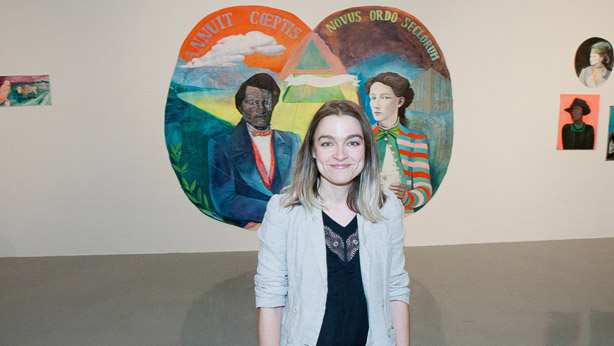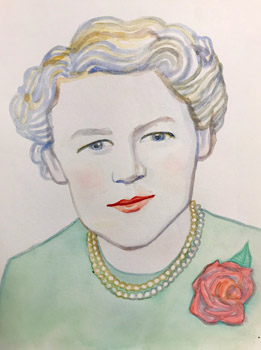Painting Female Presidential Candidates Back Into History
Mason Gross student and Eagleton Fellow creates portraits of more than 75 women who have run for president

Valerie Suter was raised in New York City and Washington, D.C., on a steady diet of politics and art. She continues to thrive on both.
Her father, a sculptor and a painter, worked as a political illustrator for publications such as The New York Times, TIME magazine, and The Washington Post, and her mother is a painter with a career in book publishing. As the MFA student tells it, “creative work as well as an awareness and engagement with writing and politics was ever-present when I was young.”
This semester, Suter plunges even deeper into her inquiry of the ways government and art inform one another through the Rutgers University Eagleton Fellowship Program in Politics and Government. The one-year, interdisciplinary fellowship is awarded to select graduate students. Suter, who earned a bachelor’s degree in history at Montreal’s McGill University before studying art for a year at Central St. Martins in London, is only the second Mason Gross student – and the first from the Department of Art & Design—to receive this honor. As part of the program, Suter is taking a course on American politics this semester, and in the spring will complete an internship in a government department or agency.
Art and politics intersect in Suter’s latest project, a series of painted portraits of women who have made a run for the U.S. presidency. Suter says the idea began gestating in the months leading up to the 2016 presidential election. She combed newspaper and campaign archives, read widely, and picked through images in print and online to scare up reference material.
It wasn’t easy.
“When I began researching the history of these women, it was jarring to realize how many have run – over 75 – and how little-known most of them are,” says Suter. She notes that Victoria Woodhull was the first female U.S. presidential candidate. Woodhull ran in 1872 against incumbent Republican Ulysses S. Grant and Democrat Horace Greeley, before women even had the right to vote.
Learning about anyone who succeeds in trying to do something of this magnitude in the face of almost-certain failure is always inspiring and gives me hope and faith in the human spirit.
As painful as the research was – and that’s the word Suter uses to describe the process, as she was confronted with the reality of how women and other groups were excluded from public office – she also admits that “learning about anyone who succeeds in trying to do something of this magnitude in the face of almost-certain failure is always inspiring and gives me hope and faith in the human spirit.”
Suter’s goal, among others: paint these women back into history.

“It felt imperative to try to bring them to life by painting them and introducing them to viewers,” says Suter. She says she hopes to exhibit her completed series in 2020 to mark the centennial of the passage of the 19th Amendment, which granted women the right to vote.
The past is never past for Suter. Her project isn’t merely about saluting historical subjects, but about getting up close and personal with these women.
“I’m interested in portraiture because I’m interested in people,” Suter says. “Painting individuals who fascinate and/or inspire me has been a way for me to reflect on something about their presence… It’s a way to spend time with them.”
It’s tempting to label Suter a “political” artist. But she tiptoes around the characterization. Yes, Suter clearly believes in the power of art to change people’s minds and, to that end, affect public policy. But the last thing she seems interested in is wielding her paintbrush in the service of didacticism.
“I gravitate towards work that offers a slow read and evokes empathy by showing or questioning something and letting the viewer find his or her own way to a point of view,” she says.
In some ways, she views her work as a kind of excavation, a means of holding up to the light long-buried stories.
And in doing so, Suter says, she hopes that the events of the past might even impact the future, that viewers of her work might understand that “the world we live in has been invented by people, and that we as individuals should all feel that we have power, both personally and politically, to shape our worlds and realities.”